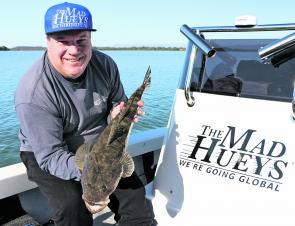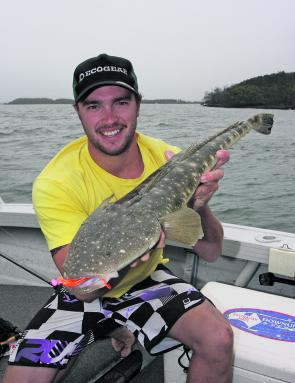September is the first month of spring and with it comes some very fertile fishing on the Gold Coast in- and offshore.
In September the snapper should be biting their heads off. They are one of Australia’s most popular sport fish, so why not get out there and chase a few.
You will find snapper on almost all of the offshore reefs east of the southern Gold Coast but areas such as the 36 fathom line off of Surfers Paradise and the Tweed as well as the Mud Hole and Fidos Reef are always a bit of a winner.
Lightly weighted whole pilchards fished slowly down to the bottom, with a small Mccubbin glow sinker is my favourite way to catch snapper, but soft plastics weighted accordingly to depth and current is also more than effective at times.
When fishing baits, I prefer monofilament fishing line, I think because snapper have very hard mouths you need to have a fair bit of stretch, otherwise I think you will be likely to pull hooks more often. Although, I’ve had far better success with soft plastics using braid, this is probably due to you being able to work the lure better and also feel bites a lot easier. With both braid and mono lines I use around 20-30lb breaking strain.
Cobia should be causing a ruckus on our local grounds, and these hard dirty fighters are not only great sport but also a fantastic table fish. Cobia are best targeted with big live baits and most times, live bait species is not that important; tarwhine, juvenile snapper, tailor, yellow tail and slimeys are all really good live baits and anything around a kilo or so will do.
It’s time to dust off the heavy gear when cobia fishing, although you will land even the biggest cobias on fairly light line. If there is a few boats in the area these fish are much more manageable on 15-24kg lines. Use a leader of around 1m in length and a breaking strain of around 80lb with either one or two 7/0 to 9/0 hooks depending on the live bait that are on offer.
A little bit wider off of the Coast at the 42 and 50 fathom line you will be likely to encounter good number of pearl perch, pigfish and morwong. Most of these fish live close to the bottom so I find the most effective way to target them is with a paternoster rig with 2 or 3 droppers. I prefer either a gang of two 5/0 or a single 6/0 circle hook on my droppers with a glow in the dark bead just above the hook.
Probably the most commonly made mistake when fishing for these fish is using baits that are too big; half pilchard, flesh or squid baits of similar size are more than big enough. You will catch far more fish with slightly smaller bait. When fishing deep, braid is the only way to go. You will feel the bites through the line far easier.
Flathead should be in plague proportions during September. Soft plastics are the most effective and the most enjoyable way to target this species.
For flatties I like to use a soft plastic tails of around 3-4”, such as a 4” Mcarthy paddle-tail, as they are the most versatile size and will catch flathead of all sizes from little wigglers to shovel headed monsters. Most of your flathead fishing can be done with jigheads of around 1/4-3/8oz and a hook of around a 4/0. These two sizes are probably the most versatile.
Flathead are an ambush predator so by fishing areas like drains or drop-offs at the last of the run-out tide you will have a good chance of finding fish in a feeding frenzy.
If the flatties are shut down on plastics, it is always worth a troll with hardbodied lures, such as the Lively Lures Micro Mullet as these account for plenty of fish and are often great to use when prospecting new spots.
Big winter bream should be well and truly on offer throughout September, these fish can be caught using countless methods. Lure fishing for bream has taken Australia by storm and this is a perfect time of year to get amongst a few. Casting lightly weighted soft plastics and hardbodied lures around pontoons or moored boats will put you in with a chance of crossing paths with a few bream. You could also try deeper sections, such as the Southport Seaway or the Tweed Bar with plastics rigged on 1/16oz jigheads. The newest bream plastic on the market is the Ecogear Aqua Bream Prawn, I’ve been using this lure for the past few months and I’m yet to fault it. Bream just love the taste of this thing!
To catch bream consistently you have to go for a stealthy approach with light line and leader works best. Lines anywhere from 2-6lb are best for bream and for leader I’ll try to use 6lb or lighter for most applications.
There will still be a few decent tailor getting about this month and when these things are schooled up they can be ravenous. Tailor are best found in the estuaries following the first push of clean water on the run-in tide. They can be caught casting or trolling metal or hardbodied lures. I find if schools of tailor aren’t visibly apparent, try trolling a couple of deep diving minnows around the bars and entrances, because chances are they are still there but perhaps a bit deeper than usual.
On the beaches there will again be good numbers of tailor and also some thumper bream. Try fresh sand worms for the bream and pilchards for the tailor. Just a standard running ball sinker down to a leader of around a metre in length. I use about 40lb for tailor and 10-12lb trace for bream.
Reads: 1867
Brad Job with just one of many caught during the Dash for Cash competition.

Flathead should be in plague proportions during September and soft plastics are the most effective way to catch them.




